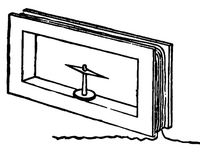
Current can be measured by a galvanometer, via the deflection of a magnetic needle in the magnetic field created by the current.
The ampere (symbol: A) is the SI unit of electric current[1] (symbol: I) and is one of the seven[2] SI base units. It is named after André-Marie Ampère (1775–1836), French mathematician and physicist, considered the father of electrodynamics. In practice, its name is often shortened to amp.
In practical terms, the ampere is a measure of the amount of electric charge passing a point in an electric circuit per unit time with 6.241 × 1018 electrons, or one coulomb per second constituting one ampere.[3]
The practical definition may lead to confusion with the definition of a coulomb (i.e., 1 amp-second), but in practical terms this means that measures of a constant current (e.g., the nominal flow of charge per second through a simple circuit) will be defined in amps (e.g., "a 20 mA circuit") and the flow of charge through a circuit over a period of time will be defined in coulombs (e.g., "a variable-current circuit that flows a total of 10 coulombs over 5 seconds"). In this way, amperes can be viewed as a "rate of flow" and coulombs viewed as an "amount of flow."
see also[]
References / sources[]
- ↑ BIPM official definition
- ↑ The other six are the metre, kelvin, second, mole, candela, and kilogram
- ↑ Bodanis, David. (2005). Electric Universe. New York: Three Rivers Press. ISBN 978-0307335982
Extract from Wikipedia article.
| This standards- or measurement-related article is a stub. You can help Tractor & Construction Plant Wiki by expanding it. |